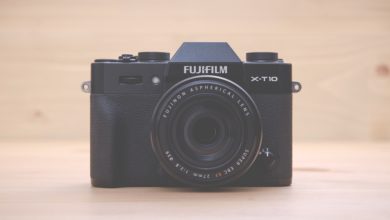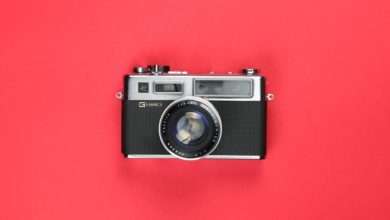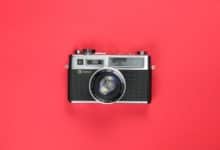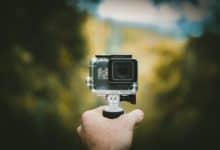Nikon D7500 Review
 The D7500 is the eighth in a venerable lineup of Nikon DSLRs that started with the D70. Their D7200 was recently featured in our list of Best cameras for Youtube.
The D7500 is the eighth in a venerable lineup of Nikon DSLRs that started with the D70. Their D7200 was recently featured in our list of Best cameras for Youtube.
The Nikon D7500 is a mid-range APS-C DSLR that comes with a 20.9MP sensor, a high-res metering sensor, and an excellent image processor.
I guess you could say in a lot of ways; the D7500 is like the mini D500, which in itself is a miniature version of the D5. One standard quality, however, is that all three of the cameras mentioned above are built for speed.
Here’s a glance at the key features that the D7500 has:
- 20.9MP APS-C CMOS Sensor.
- 51-point phase-detect AF.
- 180k-pixel RGB sensor.
- 4K (UHD) video recording.
- Deeper grip and weather-sealing.
- Wi-Fi and Bluetooth.
Compact and Functional Design Structure:
 The D7500 is comparatively lighter than it’s older D2700 by around 5% and almost 16% lighter than the D500. It weighs at about 640 grams. However, that doesn’t mean the camera lets you down in the feel it gives when you use it. When compared to the D2700, the handgrip of the D7500 is more in-depth and has a combined soft-texture coating that covers the front and the rear of the grip. This makes the D7500 more secure and comfortable to be handheld for longer hours.
The D7500 is comparatively lighter than it’s older D2700 by around 5% and almost 16% lighter than the D500. It weighs at about 640 grams. However, that doesn’t mean the camera lets you down in the feel it gives when you use it. When compared to the D2700, the handgrip of the D7500 is more in-depth and has a combined soft-texture coating that covers the front and the rear of the grip. This makes the D7500 more secure and comfortable to be handheld for longer hours.
The D7500 is also weather-proofed, which allows you to keep shooting when the weather acts up. While the D7200 had magnesium alloy panels, the D7500 has been given a single monocoque construction, which helped in reducing the overall weight of the camera. Thankfully, the replacement of materials didn’t leave a plasticky feel to the camera.
D7500’s optical viewfinder is very similar to that of the D2700. It has an 18.5 mm eyepoint and a magnification capability of around 0.94x and 100% coverage. However, an added feature is the sensor that can be used to turn the rear LCD off when the camera is placed near your eye.
The rear display is a lot slimmer, smoother and fluid. The touch operations can be used in menus, playback, and during live view shooting mode. The rear display can be tilted upwards and downwards. This is one of the first times that a touchscreen has been installed into a Nikon DSLR.
There’s also a tap-to-focus control where you can tap any area of the screen you please, and the camera will focus there and trigger the shutter at the same time. The touchscreen allows for easier access to reviewing images that have been clicked, which means you can change between viewing and capturing quick enough to re-take a shot.
There is a single memory card slot in the D7500 if you want more than one slot, but a similar camera feels, then you can look at the D500. UHS-I memory cards are supported by the camera but not the UHS-II; what this technically means is that you can use UHS-II cards, but the cards won’t work to their fullest potential.
The camera is equipped with a microphone and headphone jack. It also includes USB, HDMI Type C, and remote trigger/accessory terminals.
Image Quality:
 The D7500’s AF system received a Group-Area AF mode, which we can witness almost initially in use. This mode enhances subject detection and tracking making it very easy to focus and isolate noise and background in images. The D7500 continuously monitors over five different AF fields, which are highly impressive.
The D7500’s AF system received a Group-Area AF mode, which we can witness almost initially in use. This mode enhances subject detection and tracking making it very easy to focus and isolate noise and background in images. The D7500 continuously monitors over five different AF fields, which are highly impressive.
The camera is quick in capturing moments with its 8fps burst, 100+ JPEG, and 50 RAW buffers. It has quite a reliable autofocus system with excellent subject recognition that creates a competent camera. However, one drawback is the lack of a vertical grip option – if you want this option, you would have to go higher up and invest in a D500.
The D7500 also has some of the best low light image quality of any APS-C camera that would be available currently in the market. But be a little careful that JPEG noise reduction at higher ISO levels can be heavy-handed and may make your images look a little cluttered or unprofessional. Instead, you can opt to either dial down your ISO or shoot in RAW, which offers better quality images in low light settings. The camera produces JPEGs with mostly accurate and very aesthetic tones and offers almost no significant real-to-view color difference.
Video:
 The D7500 can shoot 4k/ UHD video with a rate of 144Mbps for just under 30 minutes at continuous shooting. The quality of the 4K video is excellent, and the camera is also capable of recording FHD videos at up to 60fps.
The D7500 can shoot 4k/ UHD video with a rate of 144Mbps for just under 30 minutes at continuous shooting. The quality of the 4K video is excellent, and the camera is also capable of recording FHD videos at up to 60fps.
The camera is quite capable of good-looking video output right from the camera, but the D7500 is still not the first choice we would recommend to newbie videographers. This is mostly attributed to the fact that video capture is particularly noisy, clumsy, and jumpy. It’s almost unusable in capturing life’s most significant movements.
This is all under the auto mode; if you switch to manual, you’ll be in even more trouble as the camera doesn’t give you focus options to help out in background difference and focus capture. It is also considered challenging to get a stable shot as the camera doesn’t have inbuilt sensor-based image stabilization.
One of the best features’s that this camera has to offer concerning videography is its 3D tracking ability. The camera tends to latch itself to your subject of choice with ease, and it’s 51-point AF system provides more than enough coverage that you can shoot subjects close to the edge of the camera’s frame.
Battery Life:
The D7500 is equipped with the updated EN-EL15a battery. It is backward compatible and offers 950 shorts per charge according to the CIPA ratings. However, you can quickly get around 2000+ shots using both RAW and JPEG and can be in use for over 8+ hours at a stretch and still have a good amount of battery to save you for any surprise clicks.
Conclusion:
 Most of us know how glorious a camera the D7200 was and how it changed the market with its launch. While most of us expected better from the D7500, the camera did fall short in a couple of areas. However, there is quite a bit of pro that makes the D7500 worth every penny. It’s comparatively one of the smallest D7 series of Nikon; it offers the very familiar button layout that people have become accustomed to over the years, has one of the best weather sealing proofs, and a much better and comfortable grip. The touchscreen is also extremely responsive.
Most of us know how glorious a camera the D7200 was and how it changed the market with its launch. While most of us expected better from the D7500, the camera did fall short in a couple of areas. However, there is quite a bit of pro that makes the D7500 worth every penny. It’s comparatively one of the smallest D7 series of Nikon; it offers the very familiar button layout that people have become accustomed to over the years, has one of the best weather sealing proofs, and a much better and comfortable grip. The touchscreen is also extremely responsive.
In a necessary conclusion, the D7500 is currently one of the best, if not the best, sports and action cameras on the market. It is also suited for still photography and portraits. It includes a bunch of features that make shooting and tracking more easier, including its subjects tracking fast burst rate, deeper buffer, and amazingly high quality of images in both good lighting as well as low exposure settings. However, for budding videographers, we believe that there are better choices available in the market that can do a better job than the D7500.






